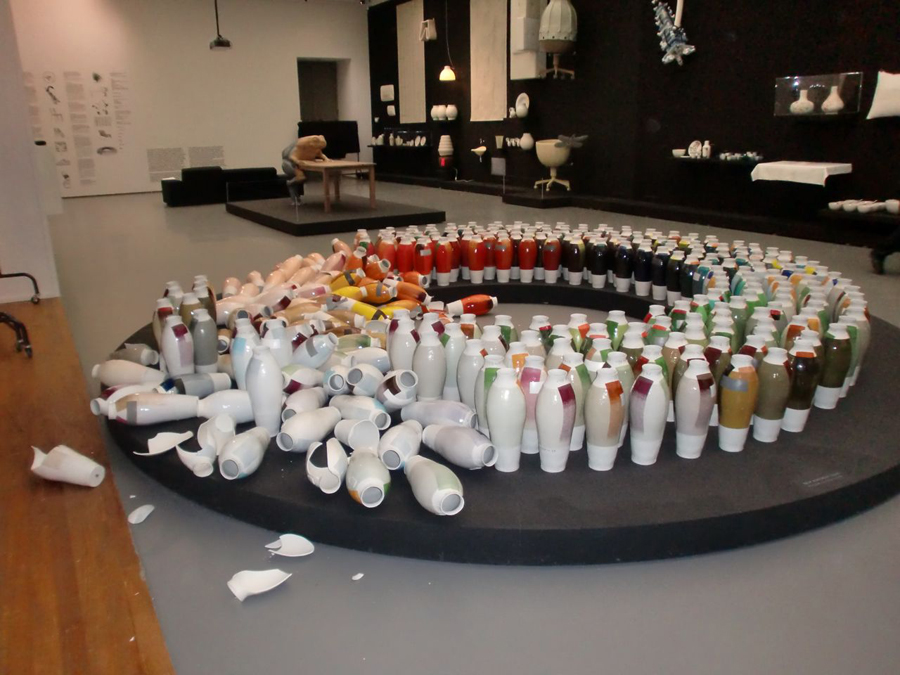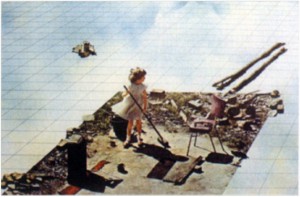Monday, February 28, 2011
Na mijn eerste kennismaking met het werk van Hella Jongerius had ik direct een hele sterke mening gevormd.
Gaandeweg ik aan het schrijven was hoe ongelofelijk simpel ik haar werk vond zoals bijvoorbeeld een door haar ontworpen print voor een sneaker moest ik toch telkens mijn mening bijstellen.
Zodoende ben ik zeven keer overnieuw begonnen. Telkens uit een verschillend standpunt. Ik moest en zou duidelijk maken hoe ongelofelijk slecht ik haar werk vond. Maar telkens naarmate ik me meer en meer verdiepte bleek ik ongelijk te hebben.

Ik vond bijvoorbeeld uit dat wanneer ik in google: “Hella Jongerius kunst” intikte 32.400 resultaten kreeg. En wanneer ik: “Hella Jongerius design” intikte 163.000 resultaten kreeg. Ook op Facebook wordt zij twee keer onder design genoemd en niet onder kunst. Ook verschillende zoektermen in google geven duidelijk meer resultaten wanneer Hella Jongerius met zoekterm “design” word gebruikt.
Zo besloot ik: “Hella Jongerius moest uit het (kunst)museum.” Na verder research over design in kunst musea bleek het Boijmans van Beuningen zelfs vrij bekend is om de manier waarmee zij design een plek in het museum geven. Een designer (Wim Crouwel) was zelf in de jaren 90tig diresteur ervan. Daarbij bleek ook dat Jongerius zichzelf niet zo zeer een kunstenaar of designer noemt maar verschillende dingen op verschillende manieren benaderd. Het kwam er dus op neer dat Jongerius werk doordacht is. Iets meer probeert dan alleen maar design te zijn.
Zo kwam ik telkens mezelf weer tegen. En moest ik toch weer nuanceren. Door telkens opnieuw te beginnen en zoveel verschillende standpunten te hebben ingenomen ben ik heel veel te weten gekomen over Jongerius.
Nog steeds staat een groot deel van Jongerius werk me tegen. Maar wat ik wel ben gaan zien is dat ze niet alleen commercieel werk maakt of veel geld probeert te verdienen met reproducties. Wat ze doet komt wel degelijk ergens vandaan. Jongerius gaat te werk als een kunstenares en vormt vanuit daar vaak toch functionele objecten of gebruiksvoorwerpen. Dit begint al in het ontwerp proces. Ze stelt zo nog meer eisen als iemand die enkel vanuit kunst of enkel vanuit design beoordeeld. Designers die zich begeven in de kunstwereld worden geacht autonoom te kunnen werken met een eigen handschrift en/of thematiek. Maar tegelijk moeten ze aanvoelen wat de markt wil. Toch lukt Jongerius dit erg goed. En voert ze daarnaast een interessant onderzoek uit naar de cross-over tussen deze twee werelden die steeds vaker hand in hand gaan.
In mijn research naar Hella Jongerius en design in de kunstwereld kwam ik op een blog geschreven door “deDeurs” Naar aanleiding hiervan ontstond een discussie…
(more…)
Thursday, February 3, 2011
Superstudio was founded in 1966 in Italy. The group developed as a result of the expanding cities, which contributed to the growing amount of products and design. Later on they focused more on architecture and on collages and cut outs they did city plans of over expanding cities.
I like the fact that their plans never became reality but their concepts were sold and exhibited. They established radical surrealistic visions of a negative environment as critiques of contemporary movements. They lived in a time when it was hard to escape from the time pressure and the fast developments. Like now, designers have to go outside expectations and think further and in the end present authentic products, sometimes-overdeveloped products. What Superdstudio did (in some of their work) was that they stopped during the process of development and did not finish it. This was a revolutionary way of thinking during that time. It is a concept that allows the spectators to walk into an unfinished world.
Superstudio has influenced a lot of designers and architectures today with its radical and revolutionary ideology. Rem Koolhaas is one of them who have made a lot extravagant projects. There is a similarity of the buildings he does and the Superstudios sketches. He is also more interested in the city and urbanisation and in a contradictive way he builds dynamic, futuristic buildings.
“ If design is merely an inducement to consume, then we must reject design. If architecture is merely the codifying of bourgeois model of ownership and society, then we must reject architecture. If architecture and town planning is merely the formalization of present unjust social divisions, then we must reject town planning and its cities until all design activities are aimed towards meting primary needs. Until then, design must disappear. “
I like the fact that their plans never became reality but their concepts were sold and exhibited. That is one reason I think they are more like artists then designers. They used their designer skills and knowledge but pushed it further so their work became artworks. A designer solves problems and an artist asks questions. Superstudio asked questions. They gave one solution out of millions and force the spectator to use his imagination to expand this solution.
In 1970 they did a furniture collection out of their “Grid concept”. It is a 3d object out of their drawings, so from design they made art, and from art they designed. But how come they neglected design when they at the same time were involved in it and produced? Is it fair to their belief? What they designed here was a response on the political issues that existed during that time and the disillusionment, which gave origin to a new society, which off course affected the art world. In this collection the furniture reminded of cheap café furniture’s from the 50s. The functionality and easiness of it was the main goal.




